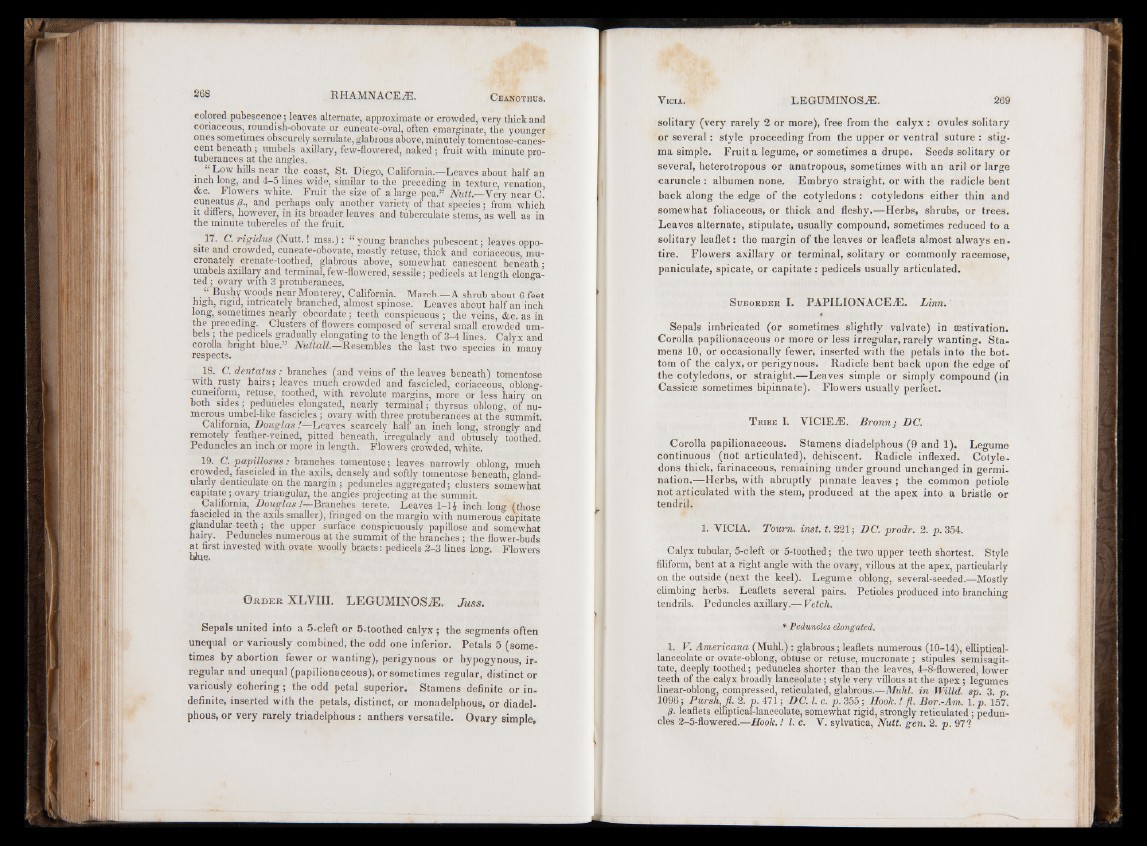
colored pubescence; leaves alternate, approximate or crowded, very thick and
coriaceous, roundish-obovate or cuneate-oval, often emarginate, the younger
ones sometimes obscurely serrulate, glabrous above, minutely tomentose-canes-
cent beneath ; umbels axillary, few-flowered, naked ; fruit with minute protuberances
at the angles. r
“ Low hills near the coast, St. Diego, California.—Leaves about half an
inch long, and 4-5 lines wide, similar to the preceding in texture, venation
&c. Flowers white. Fruit the size of a large pea.” Nutt.—Very near C.
cuneatus /?., and perhaps only another variety of that species; from which
it differs, however, in its broader leaves and tuberculate stems, as well as in
the minute tubercles of the fruit.
. & rigidus (Nutt.! mss.) : “ young branches pubescent; leaves opposite
and crowded, cuneate-obovate, mostly retuse, thick and coriaceous, mu-
cronately crenate-toothed, glabrous above, somewhat canescent beneath *
umbels axillary and terminal, few-flowered, sessile; pedicels at length elongated
; ovary with 3 protuberances.
“ Bushy woods near Monterey, California. March—A shrub about 6 feet
high, rigid, intricately branched, almost spinose. Leaves about half an inch
long, sometimes nearly obcordate; teeth conspicuous ; the veins, &c. as in
the preceding. Clusters of flowers composed of several small crowded umbels;
the pedicels gradually elongating to the length of 3-4 lines. Calyx and
corolla bright blue.” Nuttall.—Resembles the last two species in many
respects. ;
18. C. dentatus: branches (and veins of the leaves beneath) tomentose
with rusty hairs; leaves much crowded and fascicled, coriaceous, oblong-
cuneiform, retuse, toothed, with revolute margins, more or less hairy on
both sides; peduncles elongated, nearly terminal; thyrsus oblong, of numerous
umbel-like fascicles ; ovary with three protuberances at the 'summit.
California, Douglas!—Leaves scarcely half an inch long, strongly and
remotely feather-veined, pitted beneath, irregularly and obtusely toothed.
Peduncles an inch or more in length. Flowers crowded, white.
19. C. papillosus: branches tomentose; leaves narrowly oblong, much
crowded, fascicled in the axils, densely and softly tomentose beneath, gland-
ularly denticulate on the margin ; peduncles aggregated; clusters somewhat
capitate ; ovary triangular, the angles projecting at the summit.
California, Douglas /^Branches terete. Leaves 1—14 inch long (those
fascicled in the axils smaller), fringed on the margin with numerous capitate
glandular teeth; the upper surface conspicuously papillose and somewhat
hairy. Peduncles numerous at the summit of the branches; the flower-buds
at first invested with ovate woolly bracts: pedicels 2-3 lines long. Flowers
blue.
Order XLVIII. LEGUMINOSiE. Juss.
Sepals united into a 5-cleft or 5-toothed c a ly x ; the segments often
unequal or variously combined, the odd one inferior. Petals 5 (sometimes
by abortion fewer or wanting), perigynous or hypogynous, irregular
and unequal (papilionaceous), or sometimes regular, distinct or
variously cohering; the odd petal superior. Stamens definite or indefinite,
inserted with the petals, distinct, or monadelphous, or diadel-
phous, or very rarely triadelphous : anthers versatile. Ovary simple,
solitary (very rarely 2 or more), free from the calyx : ovules solitary
or sev era l: style proceeding from the upper or ventral suture : stigma
simple. Fruit a legume, or sometimes a drupe. Seeds solitary or
several, heterotropous or anatropous, sometimes with an aril or large
caruncle : albumen none. Embryo straight, or with the radicle bent
back along the edge o f the cotyledons : cotyledons either thin and
somewhat foliaceous, or thick and fleshy.— Herbs, shrubs, or trees.
Leaves alternate, stipulate, usually compound, sometimes reduced to a
solitary leaflet: the margin o f the leaves or leaflets almost always en .
tire. Flowers axillary or terminal, solitary or commonly racemose,
paniculate, spicate, or cap ita te: pedicels usually articulated.
S uborder I. PAPILIONACE^E. L in n .'
4
Sepals imbricated (or sometimes slightly valvate) in aestivation.
Corolla papilionaceous or more or less irregular, rarely wanting. Stamens
10, or occasionally fewer, inserted with the petals into the bottom
o f the calyx, or perigynous. Radicle bent back upon the edge o f
the cotyledons, or straight.— Leaves simple or simply compound (in
Cassiese sometimes bipinnate). Flowers usually perfect.
T ribe I. VICIEA3. Broun; DC.
Corolla papilionaceous. Stamens diadelphous (9 and 1). Legume
continuous (not articulated), dehiscent. Radicle inflexed. Cotyledons
thick, farinaceous, remaining under ground unchanged in germination.—
Herbs, with abruptly pinnate leaves ; the common petiole
not articulated with the stem, produced at the apex into a bristle or
tendril.
1. VICIA. Toum. inst. t. 221; DC. prodr. 2. p. 354.
Calyx tubular, 5-cleft or 5-toothed; the two upper teeth shortest. Style
filiform, bent at a right angle with the ovary, villous at the apex, particularly
on the outside (next the keel). Legume oblong, several-seeded.—Mostly
climbing herbs. Leaflets several pairs. Petioles produced into branching
tendrils. Peduncles axillary.— Vetch.
* Peduncles elongated. ,
1. V. Americana (Muhl.) : glabrous; leaflets numerous (10-14), elliptical-
lanceolate or ovate-oblong, obtuse or retuse, mucronate ; stipules semisagit-
tate, deeply toothed; peduncles shorter than the leaves, 4-8-flowered, lower
teeth of the calyx broadly lanceolate ; style very villous at the apex ; legumes
linear-oblong, compressed, reticulated, glabrous.—Muhl. in Willd. sp. 3. p.
1096; Pursh,Jl. 2. p. 471; DC. 1. c. p. 355; Hook.! fl. Bor.-Am. 1. p. 157.
0. leaflets elliptical-lanceolate, somewhat rigid, strongly reticulated ; peduncles
2-5-flowered.—Hook. 1 l. c. V. sylvatica, Nutt. gen. 2. p. 97?